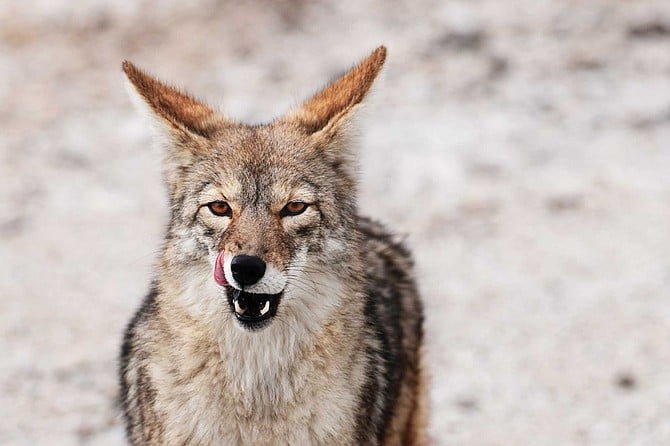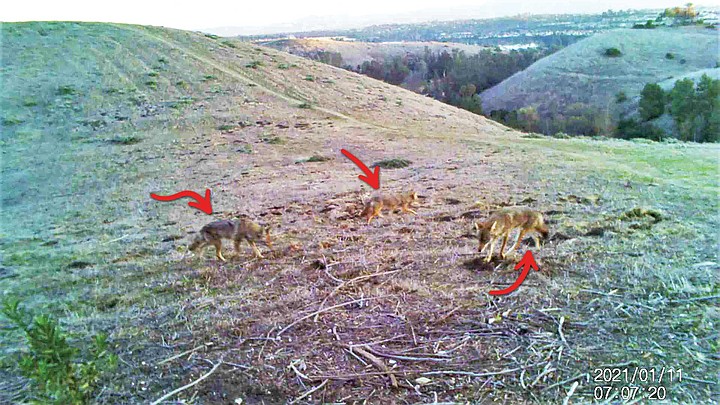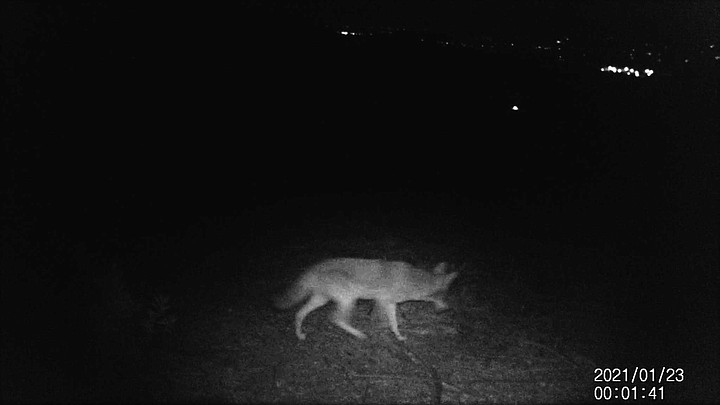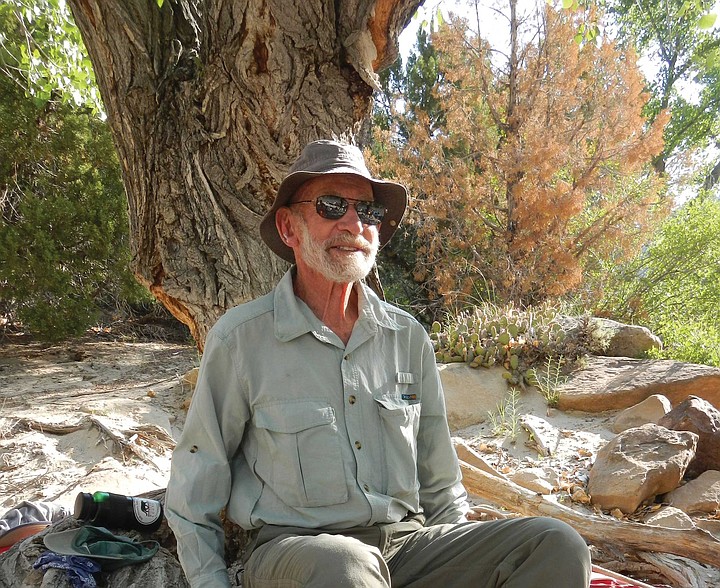 Facebook
Facebook
 X
X
 Instagram
Instagram
 TikTok
TikTok
 Youtube
Youtube

December 1, 2020, around 6 in the morning; that was the first time I saw a coyote. I didn’t see it in person, just on camera. I saw the upper half of its face as it moved through the bottom of the frame. Dew had covered most of the lens of the motion-activated camera in water droplets, giving me a fleeting and blurry glimpse of the evasive creature. It wasn’t much, just a few seconds of the barely distinguishable animal, padding its way across the brown, flat earth on an overcast morning. It was still thrilling.

I remember my giddy wonder and excitement the morning I biked to retrieve the camera, hearing the soft crunch of gravel under the wheels until I reached the canyons just south of Mount Soledad and the shrub to which I had haphazardly fixed the device. It was only $40 on Amazon, but to me, looking through the pictures it took was like opening a wrapped present, a glimpse into the lives of animals that moved throughout the canyon at dawn and dusk. And the most common animal was the coyote. Each time I retrieved the SD card, more and more sightings rolled in. January 13, I caught one gliding across the hard packed clay, its eyes shining like two bright miniature suns as it looked directly at the camera. January 11, I saw two of them — one during the morning and one at night. January 22, I filmed one that had a reddish tint in the thick fur on its shoulders. January 23, another at two in the morning. I’d always known they were present, as occasionally their thin veil of secrecy was punctured by their loud yipping, advertising their presence near Kate Sessions. I’d heard them but never seen them before, and I had absolutely no idea just how abundant the population was.

It seems that most of San Diego is like this. The local social network Nextdoor has become a veritable coyote sighting billboard. Perhaps the thing that makes people devote so much of their attention to keeping track of coyote sightings is the animal’s potential to eat meat. Specifically, to wreak bloody havoc on people’s dogs, cats, chickens, and livestock. Michelle Fortin recalled a time when she was living in Carmel Valley and her dog was attacked at night by a coyote that had jumped over her six-foot fence. “I ran to them when I heard him cry out and was able to scare the coyote into letting go of him so he could escape to the house. We left the gate open for the coyote to leave and never saw one in our yard again.” Despite the attack, she was not eager to see the coyote destroyed, a seemingly common sentiment among locals. “It was frightening, and a tough road to recovery for the dog, but I still would oppose any efforts to get rid of the coyotes,” she said.

The California Department of Fish and Game estimates the California coyote population at 250,000. San Diego is likely home to tens of thousands. Nationwide, they inhabit the entire US except for Hawaii, with a population numbering in the millions. Native to the Rocky Mountains, the Great Plains, and the deserts of the Southwest, coyotes had begun expanding into northern California, Oregon, and Washington by the late 19th century. In the early 1900s, they pushed into the Great Lakes region and the northeast, and by 1990, they had populated the South and the East Coast, completing their conquest of the United States. But they didn’t stop there. They pushed north into Canada and Alaska, and south into the rainforests of Central America. Now, they are on the cusp of colonizing South America.

In San Diego, and in the rest of North America, the coyote owes its tremendous success to a few key factors, the first of which is the elimination of its predators. Animals such as coyotes, raccoons, and foxes are known as meso-predators. This means that they prey on smaller animals, while they themselves are prey for larger carnivores. San Diegan coyotes used to live under the shadow of the California grizzly bear and the mountain lion, but the former is now extinct and the latter has been greatly reduced in number. The near-elimination of these apex predators has likely made coyotes more bold, and allowed their populations to reach historic highs.
The second factor is the coyote’s own wily versatility. A study on coyote populations near Camp Elliott in San Diego County was conducted in 1971, and concluded that “any reduction in the density of this species can be regained after one breeding season.” The same study subtly critiqued the coyote control program at the time, stating, “Preliminary investigations have shown the coyote population in this area to be essentially the same during the removal trapping program”. Killing 75 percent of a given coyote population every year for five decades would still not exterminate the population, according to another study.
Coyotes are omnivorous; they eat rodents, rabbits, fruit, vegetables, carrion, mice, and other food items. They have a varied social structure, living as solitary individuals, in pairs, or in small family groups, depending on external metrics.
When persecuted, they tend to scatter across the landscape in singles and pairs, forming packs when conditions are favorable. They howl and yip to each other as a kind of census. If their calls are not answered by other coyotes (a sign of low population density), they have litters up to three times as large as normal. This behavior can be attributed to their pre-urbanization lifestyle, wherein populations were under constant stress from wolves, grizzlies, and other apex predators. Coyotes have struck the perfect balance between being bold enough to hunt and kill prey while being evasive and savvy enough to avoid being killed themselves (for the most part). Their ability to adjust and adapt to new conditions are unparalleled for an animal of their size, and this flexibility has allowed them to capitalize on deforestation and the expansion of urban environments — a habitat free from hunting and poisoning. The life expectancy of a city coyote is 12-13 years, while rural coyotes live a mere 3.5 years.

San Diego County is inhabited by some 3.4 million people. Put them alongside tens of thousands of coyotes in close proximity, and you have a surefire recipe for conflict, which sometimes is enough to provide motivation for hunting and eradification efforts. Actually, you don’t even need 3.4 million; whether led by the government or adventurous frontiersmen, ambitious efforts to curb coyote populations have been undertaken across the west for more than a century.
In 1891, Miguel Estudillo became San Diego county’s coyote agent. He was tasked with paying a $5 bounty per coyote killed, an act which would serve as the catalyst for a succession of eradication programs. In his first month on the job, Estudillo paid bounties on 224 coyotes, but the system failed to put a dent in the county’s coyote population. And Estudillo wasn’t the only one who tried. Between 1947 and 1956, some 6.5 million of the canines were killed in the American West, a feat made possible through 10 million dollars of federal funding and truckloads of poisoned baits.
But just as they had in San Diego, the coyote populations recovered rapidly. In the most recent fiscal year, the USDA’s Wildlife Services division euthanized 34 coyotes in San Diego “due to predation and damage threats,” and nationwide, around 500,000 coyotes per year are killed. Still, populations have continued to thrive, even though there is little to no regulation governing coyote hunting in San Diego — or the rest of the country, for that matter.
Aside from livestock predation, the most frequent threat that coyotes pose nowadays is to dogs and cats in residential areas, “They’ve become so adaptable, they are used to being around people,” explained Scott Tremor, a mammalogist with the San Diego Natural History Museum. “So they are in people’s backyards, eating neighborhood cats. They will go after small kids, although I don’t know of any being dragged away.” This situation is rather ironic: through urbanization, we have paved the way for the coyote’s success, only to have it eat our own pets.
“Just a few weeks into the lockdown when there was no traffic and nights were super quiet, I caught a big sized coyote on my camera system,” recalled La Jollan Mark Bowles. “It only hung around for a few minutes and left without eating any of my pets. It was awesome to see. I would like them to stay, as I think they are indicative of a healthy ecosystem, and I think risk is minimal and manageable.”
Longtime University City resident Brian Engleman agreed. “Hearing the coyotes in the canyon was often a nightly event; I always found it cool rather than scary. They are part of our ecosystem and help keep rodent numbers in check. True, they will go after cats and dogs, but that’s always one of the balances when humans encroach on natural habitats. I’m not anti-growth by any means, but finding ways to balance wildlife with urban life is always a good thing in my mind. We need to be diligent about not providing easy food sources in our neighborhoods, things like garbage, which will also exacerbate the problem.”
John, a mountain biker who encounters coyotes in local canyons, proposes a partial solution. “Many times, the coyotes are not particularly bothered by me, but I always go out of my way to yell at them, chase them, or throw rocks. The proper response to coyote encounters is to ‘haze’ them, to make them more afraid of humans, and therefore less willing to encounter humans to get a meal. If we all did this consistently, we would have much less of a coyote problem. People also simply need to manage their pets better — don’t let your cat out at night, don’t let your little dog out at night. That would prevent a large majority of the pet killings. For the more brazen attacks, where a coyote grabs a small dog while being walked by its owner only a few feet away — yes, those require a more forceful response. But I think most of these would be prevented by consistently working to make the coyotes fear humans again.”
However troublesome the coyote’s presence may be, it has played an influential role in local ecosystems. Michael Soulé, a UC Santa Cruz conservation biologist, says, “When we studied coyotes in the canyons of San Diego in the 1980s, we discovered that the canyons the coyotes still visited were healthier. There were more species of native birds than in canyons that coyotes couldn’t access because they were isolated from the surrounding rural areas.” In the presence of coyotes, feral cats, possums, skunks, and raccoons are less active and hunt less frequently, out of fear of coyote predation. “In this sense, it turns out that coyotes are good for native birds and ground nesting birds,” Soulé continued. “These processes are called trophic cascades. You remove one part of the ecosystem, and it causes a ripple effect through other parts of the ecosystem that depended on the absent part. This can affect both flora and fauna.”
The coyote is no wolf, but its presence as a top predator has had a generally positive influence on the surrounding biodiversity. An evolutionary epic is unfolding before our own eyes, as we are seeing ecosystems ebb and flow in response to human impacts. We have spent centuries altering the local environment, yet a thriving coyote population still remains in this region. I think there’s something resilient and perhaps inspiring about that.


December 1, 2020, around 6 in the morning; that was the first time I saw a coyote. I didn’t see it in person, just on camera. I saw the upper half of its face as it moved through the bottom of the frame. Dew had covered most of the lens of the motion-activated camera in water droplets, giving me a fleeting and blurry glimpse of the evasive creature. It wasn’t much, just a few seconds of the barely distinguishable animal, padding its way across the brown, flat earth on an overcast morning. It was still thrilling.

I remember my giddy wonder and excitement the morning I biked to retrieve the camera, hearing the soft crunch of gravel under the wheels until I reached the canyons just south of Mount Soledad and the shrub to which I had haphazardly fixed the device. It was only $40 on Amazon, but to me, looking through the pictures it took was like opening a wrapped present, a glimpse into the lives of animals that moved throughout the canyon at dawn and dusk. And the most common animal was the coyote. Each time I retrieved the SD card, more and more sightings rolled in. January 13, I caught one gliding across the hard packed clay, its eyes shining like two bright miniature suns as it looked directly at the camera. January 11, I saw two of them — one during the morning and one at night. January 22, I filmed one that had a reddish tint in the thick fur on its shoulders. January 23, another at two in the morning. I’d always known they were present, as occasionally their thin veil of secrecy was punctured by their loud yipping, advertising their presence near Kate Sessions. I’d heard them but never seen them before, and I had absolutely no idea just how abundant the population was.

It seems that most of San Diego is like this. The local social network Nextdoor has become a veritable coyote sighting billboard. Perhaps the thing that makes people devote so much of their attention to keeping track of coyote sightings is the animal’s potential to eat meat. Specifically, to wreak bloody havoc on people’s dogs, cats, chickens, and livestock. Michelle Fortin recalled a time when she was living in Carmel Valley and her dog was attacked at night by a coyote that had jumped over her six-foot fence. “I ran to them when I heard him cry out and was able to scare the coyote into letting go of him so he could escape to the house. We left the gate open for the coyote to leave and never saw one in our yard again.” Despite the attack, she was not eager to see the coyote destroyed, a seemingly common sentiment among locals. “It was frightening, and a tough road to recovery for the dog, but I still would oppose any efforts to get rid of the coyotes,” she said.

The California Department of Fish and Game estimates the California coyote population at 250,000. San Diego is likely home to tens of thousands. Nationwide, they inhabit the entire US except for Hawaii, with a population numbering in the millions. Native to the Rocky Mountains, the Great Plains, and the deserts of the Southwest, coyotes had begun expanding into northern California, Oregon, and Washington by the late 19th century. In the early 1900s, they pushed into the Great Lakes region and the northeast, and by 1990, they had populated the South and the East Coast, completing their conquest of the United States. But they didn’t stop there. They pushed north into Canada and Alaska, and south into the rainforests of Central America. Now, they are on the cusp of colonizing South America.

In San Diego, and in the rest of North America, the coyote owes its tremendous success to a few key factors, the first of which is the elimination of its predators. Animals such as coyotes, raccoons, and foxes are known as meso-predators. This means that they prey on smaller animals, while they themselves are prey for larger carnivores. San Diegan coyotes used to live under the shadow of the California grizzly bear and the mountain lion, but the former is now extinct and the latter has been greatly reduced in number. The near-elimination of these apex predators has likely made coyotes more bold, and allowed their populations to reach historic highs.
The second factor is the coyote’s own wily versatility. A study on coyote populations near Camp Elliott in San Diego County was conducted in 1971, and concluded that “any reduction in the density of this species can be regained after one breeding season.” The same study subtly critiqued the coyote control program at the time, stating, “Preliminary investigations have shown the coyote population in this area to be essentially the same during the removal trapping program”. Killing 75 percent of a given coyote population every year for five decades would still not exterminate the population, according to another study.
Coyotes are omnivorous; they eat rodents, rabbits, fruit, vegetables, carrion, mice, and other food items. They have a varied social structure, living as solitary individuals, in pairs, or in small family groups, depending on external metrics.
When persecuted, they tend to scatter across the landscape in singles and pairs, forming packs when conditions are favorable. They howl and yip to each other as a kind of census. If their calls are not answered by other coyotes (a sign of low population density), they have litters up to three times as large as normal. This behavior can be attributed to their pre-urbanization lifestyle, wherein populations were under constant stress from wolves, grizzlies, and other apex predators. Coyotes have struck the perfect balance between being bold enough to hunt and kill prey while being evasive and savvy enough to avoid being killed themselves (for the most part). Their ability to adjust and adapt to new conditions are unparalleled for an animal of their size, and this flexibility has allowed them to capitalize on deforestation and the expansion of urban environments — a habitat free from hunting and poisoning. The life expectancy of a city coyote is 12-13 years, while rural coyotes live a mere 3.5 years.

San Diego County is inhabited by some 3.4 million people. Put them alongside tens of thousands of coyotes in close proximity, and you have a surefire recipe for conflict, which sometimes is enough to provide motivation for hunting and eradification efforts. Actually, you don’t even need 3.4 million; whether led by the government or adventurous frontiersmen, ambitious efforts to curb coyote populations have been undertaken across the west for more than a century.
In 1891, Miguel Estudillo became San Diego county’s coyote agent. He was tasked with paying a $5 bounty per coyote killed, an act which would serve as the catalyst for a succession of eradication programs. In his first month on the job, Estudillo paid bounties on 224 coyotes, but the system failed to put a dent in the county’s coyote population. And Estudillo wasn’t the only one who tried. Between 1947 and 1956, some 6.5 million of the canines were killed in the American West, a feat made possible through 10 million dollars of federal funding and truckloads of poisoned baits.
But just as they had in San Diego, the coyote populations recovered rapidly. In the most recent fiscal year, the USDA’s Wildlife Services division euthanized 34 coyotes in San Diego “due to predation and damage threats,” and nationwide, around 500,000 coyotes per year are killed. Still, populations have continued to thrive, even though there is little to no regulation governing coyote hunting in San Diego — or the rest of the country, for that matter.
Aside from livestock predation, the most frequent threat that coyotes pose nowadays is to dogs and cats in residential areas, “They’ve become so adaptable, they are used to being around people,” explained Scott Tremor, a mammalogist with the San Diego Natural History Museum. “So they are in people’s backyards, eating neighborhood cats. They will go after small kids, although I don’t know of any being dragged away.” This situation is rather ironic: through urbanization, we have paved the way for the coyote’s success, only to have it eat our own pets.
“Just a few weeks into the lockdown when there was no traffic and nights were super quiet, I caught a big sized coyote on my camera system,” recalled La Jollan Mark Bowles. “It only hung around for a few minutes and left without eating any of my pets. It was awesome to see. I would like them to stay, as I think they are indicative of a healthy ecosystem, and I think risk is minimal and manageable.”
Longtime University City resident Brian Engleman agreed. “Hearing the coyotes in the canyon was often a nightly event; I always found it cool rather than scary. They are part of our ecosystem and help keep rodent numbers in check. True, they will go after cats and dogs, but that’s always one of the balances when humans encroach on natural habitats. I’m not anti-growth by any means, but finding ways to balance wildlife with urban life is always a good thing in my mind. We need to be diligent about not providing easy food sources in our neighborhoods, things like garbage, which will also exacerbate the problem.”
John, a mountain biker who encounters coyotes in local canyons, proposes a partial solution. “Many times, the coyotes are not particularly bothered by me, but I always go out of my way to yell at them, chase them, or throw rocks. The proper response to coyote encounters is to ‘haze’ them, to make them more afraid of humans, and therefore less willing to encounter humans to get a meal. If we all did this consistently, we would have much less of a coyote problem. People also simply need to manage their pets better — don’t let your cat out at night, don’t let your little dog out at night. That would prevent a large majority of the pet killings. For the more brazen attacks, where a coyote grabs a small dog while being walked by its owner only a few feet away — yes, those require a more forceful response. But I think most of these would be prevented by consistently working to make the coyotes fear humans again.”
However troublesome the coyote’s presence may be, it has played an influential role in local ecosystems. Michael Soulé, a UC Santa Cruz conservation biologist, says, “When we studied coyotes in the canyons of San Diego in the 1980s, we discovered that the canyons the coyotes still visited were healthier. There were more species of native birds than in canyons that coyotes couldn’t access because they were isolated from the surrounding rural areas.” In the presence of coyotes, feral cats, possums, skunks, and raccoons are less active and hunt less frequently, out of fear of coyote predation. “In this sense, it turns out that coyotes are good for native birds and ground nesting birds,” Soulé continued. “These processes are called trophic cascades. You remove one part of the ecosystem, and it causes a ripple effect through other parts of the ecosystem that depended on the absent part. This can affect both flora and fauna.”
The coyote is no wolf, but its presence as a top predator has had a generally positive influence on the surrounding biodiversity. An evolutionary epic is unfolding before our own eyes, as we are seeing ecosystems ebb and flow in response to human impacts. We have spent centuries altering the local environment, yet a thriving coyote population still remains in this region. I think there’s something resilient and perhaps inspiring about that.
Comments